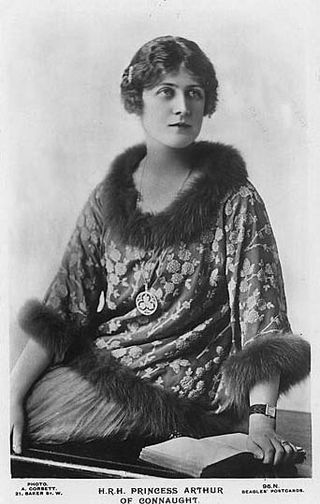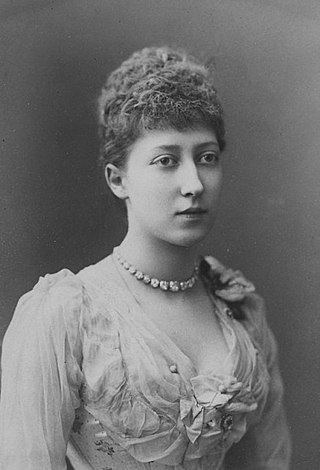History
There have been three buildings known as Mar Lodge. The first, originally known as Dalmore House, was built in the 18th century by William Duff, Baron Braco, [2] close to the site of the present Lodge. [3] Lord Braco had acquired the Dalmore estate some time between 1730 and 1737 from the Mackenzie lairds of Dalmore, and by the end of the 18th century the Duff family also owned the lands of Allanaquoich, Auchindryne and Inverey [4] The Duffs owned huge swaths of land in addition to the estate as the heads of many Scottish Feudal Baronies, including MacDuff, named for James Duff, 2nd Earl Fife. [5] [6] The building was damaged in the "Muckle Spate" ("great flood") of 1829, [7] and later demolished. [1] The lodges served as the seat for the 5th-7th Barons of MacDuff. [8]
Corriemulzie Cottage
The 2nd Mar Lodge, colloquially known as Corriemulzie Cottage or 'New' Mar Lodge, was built near Linn of Corriemulzie at the top of Mar Lodge Brae. It was a very 'Victorian' building with architectural detailing such as prominent use of lattice work (still visible on the 'Stag Ballroom') and tree-trunk supports (visible in the veranda of the old bar at the rear of Mar Lodge) being reused in the construction of the next Mar Lodge. It was destroyed by fire on the 14th of June 1895. [7]

Princess Alexandra, 2nd Duchess of Fife,, born Lady Alexandra Duff and known as Princess Arthur of Connaught after her marriage, was the eldest surviving grandchild of King Edward VII and also the first cousin of George VI. Alexandra and her younger sister, Maud, had the distinction of being the only female-line descendants of a British sovereign officially granted both the title of Princess and the style of Highness.

Alexander Arthur Alfonso David Maule Ramsay of Mar DL was the only child of Princess Patricia of Connaught, who renounced her royal title and style when she married then-Captain the Hon. Alexander Ramsay in February 1919. His mother was the youngest child of Prince Arthur, Duke of Connaught, the third son of Queen Victoria and Prince Albert. His father was the third son of John Ramsay, 13th Earl of Dalhousie. Through the marriage of his maternal aunt, Princess Margaret of Connaught, to the Swedish prince who later became King Gustav VI Adolf of Sweden, his first cousins included Prince Gustaf Adolf, Duke of Västerbotten, whose son later became King Carl XVI Gustaf of Sweden; and Princess Ingrid of Sweden, who later became Queen of Denmark after marrying the Danish prince who later became King Frederick IX of Denmark.

Alastair Arthur Windsor, 2nd Duke of Connaught and Strathearn was a member of the British Royal Family. He was the only child of Prince Arthur of Connaught and Princess Alexandra, 2nd Duchess of Fife. He was a great-grandson of Queen Victoria through his father and the first great-grandchild of Edward VII through his mother. He was also a descendant of Victoria's paternal uncle and predecessor, William IV, through an illegitimate line.

Louise, Princess Royal and Duchess of Fife was the third child and eldest daughter of King Edward VII and Queen Alexandra of the United Kingdom; she was a younger sister of King George V. Louise was given the title of Princess Royal in 1905. Known for her shy and quiet personality, Louise remained a low-key member of the royal family throughout her life.

Alexander William George Duff, 1st Duke of Fife, styled Viscount Macduff between 1857 and 1879 and known as the Earl Fife between 1879 and 1889, was a British peer who married Princess Louise, the third child and eldest daughter of King Edward VII and Queen Alexandra.

Duke of Fife is a title in the Peerage of the United Kingdom that has been created twice, in both cases for Alexander Duff, 1st Duke of Fife and 6th Earl Fife, who in 1889 married Princess Louise, the eldest daughter of Albert Edward, Prince of Wales. The dukedom of Fife was created for a member of the British royal family by marriage, since the first holder's wife was a granddaughter of Queen Victoria.
Braemar is a village in Aberdeenshire, Scotland, around 58 miles (93 km) west of Aberdeen in the Highlands. It is the closest significantly-sized settlement to the upper course of the River Dee, sitting at an elevation of 339 metres (1,112 ft).

The Lairig Ghru is one of the mountain passes through the Cairngorms of Scotland. The route and mountain pass partially lies on the Mar Lodge Estate.

Crathie Kirk is a small Church of Scotland parish church in the Scottish village of Crathie, best known for being the regular place of worship of the British royal family when they are in residence at the nearby Balmoral Castle.

Duff House is a Georgian estate house in Banff, Aberdeenshire, Scotland. Now in the care of Historic Environment Scotland, it is part of the National Galleries Scotland and is a Category A listed building.
Inverey is a hamlet on Mar Lodge Estate, in Aberdeenshire, Scotland.

Mar Lodge Estate is a highland estate in western Aberdeenshire, Scotland, which has been owned and managed by the National Trust for Scotland (NTS) since 1995. Its principal building, Mar Lodge, is about 4 miles (6.4 km) west of the village of Braemar. The estate is recognised as one of the most important nature conservation landscapes in the British Isles and occupies nearly 8% of the Cairngorms National Park, covering 29,340 hectares. The natural heritage value of the estate is reflected by the fact that much of it is designated as a Site of Special Scientific Interest (SSSI), a Special Area of Conservation (SAC) and a Special Protection Area (SPA). The entire estate has been classified as a national nature reserve since May 2017, and is designated a Category II protected area by the International Union for Conservation of Nature.
Glen Lui from Gleann Laoigh – calves' glen – Gordon (1925) is one of the major glens on the Mar Lodge Estate, in Aberdeenshire, Scotland.

Victoria Bridge is the early 20th century lattice girder bridge over the River Dee at Mar Lodge on Mar Lodge Estate, Aberdeenshire, Scotland. This bridge, built in 1905 and replaced an earlier wooden bridge, built in 1848 by the Duke of Leeds during his tenancy of the estate. The archway at the south end of the bridge bears '1848 Queen Victoria 1848' on the south side and '1905 Edward VII 1905' commemorating the construction of both bridges and the reigning monarch at the time.
Corriemulzie is a locality on Mar Lodge Estate, Aberdeenshire, Scotland.
Mar Lodge Estate is the largest remnant of the ancient Earldom of Mar in Aberdeenshire, Scotland and is now owned by the National Trust for Scotland.

Ballater railway station is a former station in the village of Ballater in Aberdeenshire, Scotland. The station was formerly the terminus of a branch line from Aberdeen.
Alexander Marshall MacKenzie was a Scottish architect responsible for prestigious projects including the headquarters of the Isle of Man Banking Company in Douglas, and Australia House and the Waldorf Hotel in London.

St Ninian's Chapel in Braemar, Aberdeenshire, Scotland, is a Grade B listed Anglican chapel located in the grounds of the Mar Lodge Estate. Built from 1895 to 1898 for use as a private chapel by the family of Alexander Duff, 1st Duke of Fife, owners of Mar Lodge, it has been the property of the Diocese of Aberdeen and Orkney in the Scottish Episcopal Church since 1899. St Ninian's Chapel is the most westerly church in the Diocese.

Braco's Banking House is a three-storey town house in Elgin, Moray in Scotland. The home and business place of banker William Duff of Braco from 1703 to 1722, the house has borne his name ever since. It was designated a Category A listed building in 1970.






















